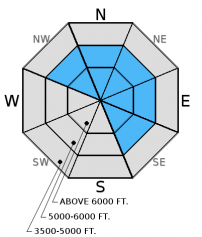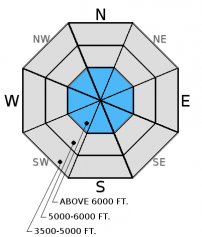| Tuesday | Tuesday Night | Wednesday | |
|---|---|---|---|
| Cloud Cover: | Partly cloudy with light winds | Light snow | Light snow |
| Temperatures: | 22-30 deg. F. | 12-20 deg. F. | 19-28 deg. F. |
| Wind Direction: | NW | WN | NW |
| Wind Speed: | 0-5 | 5-10 | 5-10 |
| Snowfall: | 0 in. | 1-3 in. | 1-3 in. |
| Snow Line: |
Whitefish Range
Swan Range
Flathead Range and Glacier National Park
How to read the forecast
Today, the avalanche danger above 5000 feet is MODERATE where human triggerred avalanches are possible. Pay attention to recently wind-loaded slopes where lingering wind slabs may exist as well as areas where weak snow deeper in the snowpack can more easily be triggered. Below 5000 feet all slopes are rated at LOW danger. Treat recent wind loaded terrain as suspect and carefully evaluate the snow pack and terrain before commiting to any slope.

2. Moderate
?
Above 6500 ft.
2. Moderate
?
5000-6500 ft.
1. Low
?
3500-5000 ft.
- 1. Low
- 2. Moderate
- 3. Considerable
- 4. High
- 5. Extreme
-
Type ?
-
Aspect/Elevation ?

-
Likelihood ?CertainVery LikelyLikelyPossible
 Unlikely
Unlikely -
Size ?HistoricVery LargeLargeSmall

Over the weekend up to 12 inches of new snow was accompanied by moderate winds with strong gusts. This formed 2-3 foot windslabs in the upper elevations. Wind slabs can take up to a week to stabilize after formation. The rain crust formed earlier in the week reaches into high elevations (around 7000-7500 feet) and will provide an excellent sliding surface for these slabs. It is important to carefully evaluate each slope you intend to ski or ride. Look for convex pillows of wind drifted snow on the lee sides of ridges and gullies. Pay attention to signs of instability like cracking, collapsing, "whumpfing", and, of course, recent avalanche activity.
-
Type ?
-
Aspect/Elevation ?

-
Likelihood ?CertainVery LikelyLikelyPossible
 Unlikely
Unlikely -
Size ?HistoricVery LargeLargeSmall

Good news/Bad news! The mid-November rain crust, which has been our main persistent slab problem throughout our early season, appears to be decomposing in parts of our advisory area. This means that it is becoming less of a persistent slab problem over time. Unfortunately, as this crust breaks down, the weight of the overlying snowpack, and subsequently the weight of a skier or snowmobiler will be able to affect the snow at the bottom of the snowpack. In parts of our advisory area this snow is made up of weak faceted grains referred to as depth hoar. These faceted grains near the ground are generally found in areas of thin snowpack and around rocks and brush. This is where you are more likely to trigger an avalanche on this layer. So, pay close attention to steep, rocky areas with a shallow snowpack. With recent snowfall access to the higher elevations is becoming easier and we will be tracking the development of this basal layer in the coming weeks.
The lowest elevation band (3500-5000 feet) has no to very little snow making travel and subsequent access to the upper elevations difficult in certain areas. However, as you approach the upper end of this elevation band and begin to encounter more snow, then treat those slopes as you would terrain in the mid- and upper elevation bands.
Yesterday, Erich toured into the Marion Lake area of the Flathead Range. There he found the recent storm snow and partial propagation in his stability tests in this layer. However, he was able to affect the depth hoar at the bottom of the snowpack with hard force during these tests (photo,video, observation).. He did note that the mid-November rain crust was decomposing and he was able to affect the faceted snow at the bottom of the snowpack in shallow rocky areas.
On Sunday in Canyon Creek, on east - northeast aspects, an experienced backcountry skier reported initiating 2 soft slab avalanches remotely from the flatter terrain above the slide paths. He reported the snowpack in this location as sensitive. A separate party of skiers submitted photos of this recent avalanche activity just outside the ski area boundary (photo). Skiers in the Stryker Ridge area of the Whitefish Range reported snow pack failure in their stability tests (observation).
Also on Sunday Todd and I rode into the Canyon Creek drainage in the southern Whitefish Range. On a north aspect we found approximately 2 feet of snow from our two recent storms sitting on top of the December 9 rain crust (photo, video). Our stability tests resulted in fracture and propagation at the crust/new snow interface with moderate force (ECTP 13).
Please let us know what you are seeing out there. Your observations are important and valued.
HOW TO SUBMIT OBSERVATIONS:
Email: [email protected]
Call and leave a message: 406.387.3821
You can also submit quick observations via text: 406.241.4571 (FAC mobile)
OR
Submit Snowpack Observations: http://www.flatheadavalanche.org/node/add/snowobs
Submit Avalanche Observations: http://www.flatheadavalanche.org/node/add/avyobs
Today will be a transition day with benign weather before the next storm system enters our area tonight. As of 4 a.m. temperature readings above 6000 feet range from 15º-22º F with calm to light winds out of the northwest. For today, expect a quiet day with light winds out of the northwest and temperatures into the high 20s to low 30s F.
| 0600 temperature: | 15-22 deg. F. |
| Max. temperature in the last 24 hours: | 21-26 deg. F. |
| Average wind direction during the last 24 hours: | NW |
| Average wind speed during the last 24 hours: | 0-5 mph |
| Maximum wind gust in the last 24 hours: | 0-10 mph |
| New snowfall in the last 24 hours: | 0 inches |
| Total snow depth: | 27-49 inches |
This advisory applies only to backcountry areas outside established ski area boundaries. This advisory describes general avalanche conditions and local variations always occur. This advisory expires at midnight on the posted day unless otherwise noted. The information in this advisory is provided by the USDA Forest Service who is solely responsible for its content.

































